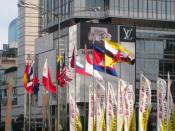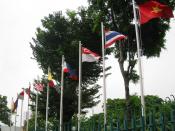Once hailed as perhaps the most successful example of regional organization in the developing world, ASEAN is now widely perceived to be in decline and ineffective (See). ASEAN, Association of Southeast Asian Nations, was founded in August 1967 to fight with an overwhelming threat of communism in Southeast Asia. The founding members were Thailand, Singapore, Malaysia, Philippines, and Indonesia. Since the Vietnam War, ASEAN's role has changed to become that of a regional peacekeeper and to maintain steady economic growth for member nations. Few more countries joined later on. Brunei joined in January 1982, Vietnam joined in 1985, Burma and Laos joined in 1997, and Cambodia joined in 1999 (See). ASEAN includes all the nations in Southeast Asia except East Timor, a newly established nation in 2000. Here, three different sides of sustainability, economic, environment, and political, will be targeted to evaluate ASEAN's effectiveness. Even though there are some controversies over ASEAN's role of non-interference in the internal affairs of one another, the failure to handle 1997 economic crisis, the failure to handle regional smog, failure to interfere with East Timor's fight for independence have proven that ASEAN needs to change its role in Southeast Asia in order to be more effective.
ASEAN made some effort to tackle the economic crisis in 1997. In December 1998, the Hanoi Plan of Action was issued by leaders at the Hanoi Summit. The plan is a set of actions that ASEAN would under take collectively to reach short-term recovery from the crisis. Moreover, ASEAN tried to make the Southeastern Asian market more attractive to foreign investors by fastening the implantation and deepening the effectiveness of AFTA, ASEAN Free Trade Area (Antara). In December 1998, ASEAN Economic Ministers agreed to advance the implement date by one year from 2003 to 2002 to restore business...



Good essay
This was exactly what I was looking for in order to get ideas and sources.
0 out of 0 people found this comment useful.